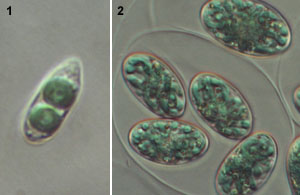| NIES-MCC | KU-MACC | Tree to Strain | Japanese | English |
| Life / Eukarya / Plantae / Glaucophyta / Glaucocystophyceae | |

|
Glaucocystis (NIES-966, 1369, 1961, 2141) Gloeochaete Cyanoptyche Cyanophora (NIES-547, 763, 764) |
|
The Glaucophyta is a small group (including only four genera as certain memebers) but is important to consider the evolution of chloroplast. Glaucophytes are basically unicellular and naked flagellate (Cyanophora) or coccoid with cellulosic or mucilage covering (Glaucocystis). They are reproduced by binary fission, zoospores or endospores. Sexual reproduction is unknown. Flagellate cell possesses hetrodynamic anterior and posterior flagella. The chloroplasts of the Glaucophyta are blue-green and show the cyanobacterial apperance (thus called cyanelles). Ultrastructurally, the chloroplast possesses bacterial cell wall (peptidoglycan) between two chloroplast membranes. THe fructose-bisphosphate aldolase (FBA) of glaucophytes is cyanobacteria-type unlike other eukaryotic photoautotrophs. Glaucophytes have no typical Light-harvesting complex (LHC) protein. Molecular phylogenetic study shows the chloroplast of the Glaucophyta is an earliest divergence in the chloroplasts (Reyes-Proetp & Bhattacharya. 2007. Mol. Biol. Evol. 24: 2358-2361). |
 1: Cyanophora (NIES-763). 2: Glaucocystis (NIES-966). |